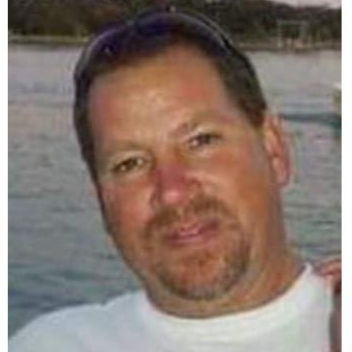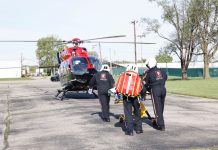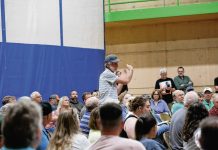Editor’s note: This is another in a series of stories focusing on Miller Prize winners for this fall’s Exhibit Columbus event downtown.
A top New York architect had heard of Columbus, certainly. But in September, Benjamin Aranda discovered that seeing is believing.
“We didn’t fully appreciate what Columbus was about until we were actually there,” Aranda said, referring to himself and firm partner Joaquin Bonifaz. “We were blown away — not just by the quality of design, but by the community’s commitment to excellent design over a period of many years.
“Here we are in New York City, where people often like to think they know everything about everything. For Columbus to be such a small area and yet have so much knowledge and investment in design — that really shocked us. And it made us want to be part of that story, especially because the city has done such remarkable work that has affected the canon of design,” Aranda added.
[sc:text-divider text-divider-title=”Story continues below gallery” ]
Aranda and Bonifaz are now a major part of that story, with their Aranda/Lasch firm’s Mill Race Park project selected among the five for the prestigious Miller Prizes linked to Exhibit Columbus, an annual art, architecture and design event. And their work, titled, “Another Circle” will be among the first of 18 temporary installations to be built for the exhibition running from Aug. 26 to late November.
The effort will include nearly 3,000 salvaged limestone slabs and pieces of various shapes and sizes scattered throughout the park that is marking its 25th anniversary. Interestingly, just after the park was designed, a young, fresh-from-college Aranda joined noted architect Stanley Saitowitz of Natoma Architects Inc., the firm that made the architectural structures for the park.
“I still remember seeing the drawings (of the park),” Aranda said.
The limestone pieces, from Bybee Stone Co. Inc. of Ellettsville, will be arranged in what will constitute a large circle, imitating the shape of perhaps the park’s most noted feature, the Round Lake. Some of the stones will be laid out like seats in a theater-oriented setting in one area. Others will be arranged to be open to interpretation from children and others, according to Aranda and Bonifaz.
They hope their stone-bedecked areas will be used for games and general relaxation.
The concept is significant enough in design circles — no pun intended — that it recently landed on the cover of New York-based architecture publication Metropolis magazine. Part of the unique nature of the project rests in both its low-tech aspect of stone and the high-tech aspect of how the stone pieces will be placed.
Aranda/Lasch designers use an app that transfers their drawing layout to a phone-style GPS layout of the park. Taylor Brothers Construction Co. of Columbus will then know precisely where to place each rock. Aranda jokingly referred to the technology as “stones and phones.”
David Doup, president of Taylor Brothers Construction Co., said he likes the idea of park visitors deciding what the stones should be once they are placed.
“I think people will use them for different things,” Doup said.
When Aranda and Bonifaz tested some of the rocks during a recent park visit, they used them as chairs.
“To me, it’s a really intriguing installation,” said Richard McCoy, founder of Exhibit Columbus and director of Landmark Columbus that cares for Columbus’ architectural heritage. “What people will see is a kind of continued discussion (since the original design) about the park, and especially connected to the landscape and water elements in the park.”
McCoy’s reference to a continued discussion is important since the origin of Exhibit Columbus is built on the idea that the exhibition’s temporary pieces will serve as conversational spinoffs, if you will, of local, noted architecture. On top of that, McCoy wants to see those spinoffs inspire new, original architecture in Columbus to keep the city at the forefront of design.
Aranda and Bonifaz hope that people catch the connection between the salvaged stone and a segment of a city salvaged from a tough past known as Death Valley.
“It’s more than symbolic,” Aranda said. “For us, that represents an ethical obligation that designers act in a way that is environmentally conscious while finding a way to re-use materials.
“And these stones have cracks and imperfections. But that stone getting a second life is something that will allow the community to come together and be part of a collective construction,” Aranda added. “It says that, in Columbus, we make new histories by using elements of the old ones.”
[sc:pullout-title pullout-title=”About ‘Another Circle'” ][sc:pullout-text-begin]
Who: Aranda/Lasch, a New York- and Tucson, Arizona-based design studio.
Piece to be installed at: Mill Race Park at Fifth and Lindsey streets in Columbus.
Consisting: Some 3,000 pieces of salvaged limestone, symbolic of Indiana’s past, of all shapes and sizes stacked and arranged in a large, 3.5-acre circle. Smaller areas will create something of a theater and a beach.
To be built: Beginning in July.
Exhibition impact: Organizers have estimated that the exhibition could draw at least 10,000 people from a regional area. But already on social media and elsewhere online, the star structures of the new event have been seen in recent months by thousands, according to participating architects.
A key of Exhibit Columbus: Five design teams representing some of the nation’s top architects recently were named as the event’s Miller Prize winners. Each winning team gets $70,000 to design and build a temporary architectural creation to complement one of those five downtown structures.
[sc:pullout-text-end]





